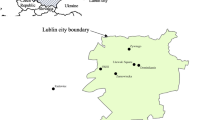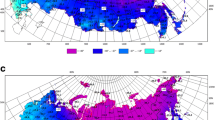Abstract
Air temperature has a very high impact on the bioclimatic conditions and climate comfort for humans. In this study, the impacts of climate change on deviation and changes in thermal and human bioclimatic conditions in Iran have been investigated. For this purpose, baseline data (1985–2016) and future data (2020–2090) of the CORDEX regional models have been investigated using the effective temperature (ET) bioclimatic index. The results showed that the air temperature in Iran will increase in the annual and seasonal pattern in the future compared to the baseline period. Sunshine hours in the upcoming period will increase significantly compared to the baseline period, so that according to the RCP8.5 and RCP4.5 scenarios, 110 and 56 h, respectively, will be added to the sunshine hours. The results of the ET index showed that one of the obvious effects of rising air temperature in the future would be the variation in the spectrum diversity and the range of human bioclimatic. In the future in all seasons, the human bioclimatic spectrum will change compared to baseline period. The spatial range of the hot, very hot and unfavorable bioclimatic spectrum will expand in the spring and summer seasons. In the future, the areas with favorable bioclimatic will be smaller and the area of unfavorable bioclimatic will be increased.








Similar content being viewed by others
References
Ahmadi H, Ahmadi F (2017) Mapping thermal comfort in Iran based on geostatistical methods and bioclimatic indices. Arab J Geosci 10(15):342
Ahmadi H, Ghalhari GF, Baaghideh M (2019) Impacts of climate change on apple tree cultivation areas in Iran. Clim Change 153(1–2):91–103
Alijani B, O’brien J, Yarnal B (2008) Spatial analysis of precipitation intensity and concentration in Iran. Theoret Appl Climatol 94(1–2):107–124
Atkinson PM, Lioyd CD, Ahangarzadeh Z (1998) Mapping precipitation in Switzerland with ordinary and indicator kriging. Special issue: spatial interpolation comparison 97. J Geogr Inf Decis Anal 2(1-2):72–86
Babaeian I, Rezaeipour A, Ahangarzadeh Z (2014) The climatic comfort index simulation in Khorasan Razavi Province under climate change scenarios. Geogr Stud Dry Areas 5(18):112–195
Barbosa R, Vicente R, Santos R (2015) Climate change and thermal comfort in Southern Europe housing: a case study from Lisbon. Build Environ 92:440–451
Batista RJ, da Gonçalves FL, Rocha RP (2016) Present climate and future projections of the thermal comfort index for the metropolitan region of São Paulo, Brazil. Clim change 137(3–4):439–454
Cheung CSC, Hart MA (2014) Climate change and thermal comfort in Hong Kong. Int J Biometeorol 58:137–148
Daneshvar MRM, Bagherzadeh A, Tavousi T (2013) Assessment of bioclimatic comfort s based on physiologically equivalent temperature (PET) using the RayMan Model in Iran. Cent Eur J Geosci 5(1):53–60
Davis RE, Knappenberger PC, Michaels PJ, Novicoff WM (2004) Seasonality of climate-human mortality relationships in US cities and impacts of climate change. Clim Res 26(1):61–76
delRío S, Herrero L, Pinto-Gomes C, Penas A (2011) Spatial analysis of mean temperature trends in Spain over the period 1961–2006. Glob Planet Change 78(1–2):65–75
Dingman SL, Seely-Reynolds M, III Reynolds RC (1998) Application of Kriging to estimating mean annual precipitation in a region of orographic influence 1. JAWRA J Am Water Resour Assoc 24(2):329–339
Eludoyin OM (2014) A perspective of the diurnal aspect of thermal comfort in Nigeria. Atmos Clim Sci 4(04):696–709
Emmanuel R (2005) Thermal comfort implications of urbanization in a warm-humid city: the Colombo Metropolitan Region (CMR). Sri Lanka Build Environ 40(12):1591–1601
Giannopoulou K, Livada I, Santamouris M, Saliari M, Assimakopoulos M, Caouris Y (2014) The influence of air temperature and humidity on human thermal comfort over the greater Athens area. Sustain Cities Soc 10:184–194
Givoni B (1963) Mean climate and architecture. Elsevier Press, Amsterdam
Invidiata A, Ghisi E (2016) Impact of climate change on heating and cooling energy demand inhouses in Brazil. Energy Build 130:20–32
IPCC (2007) Climate Change: the physical science basis. Contribution of Working Group I to the Fourth Assessment Report of the Intergovernmental Panel on Climate Change. Cambridge University Press, Cambridge, UK
Lee DH (1953) Physiological climatology as a field of study. Ann Assoc Am Geogr 43(2):127–137
Lim CL, Byrne C, Lee JK (2008) Human thermoregulation and measurement of body temperature in exercise and clinical settings. Review article. Ann Acad Med Singap 37(4):347–353
Lobanova A, Liersch S, Nunes JP, Didovets I, Stagl J, Huang S, Krysanova V (2018) Hydrological impacts of moderate and high-end climate change across European river basins. J Hydrol Reg Stud 18:15–30
Makokha GL (1998) Variations of the effective temperature index (ET) in Kenya. GeoJournal 44(4):337–343
Matzarakis A, Georgiadis T, Rossi F (2007) Thermal bioclimate analysis for Europe and Italy. Il Nuovo Cimento 30(6):623–632
Ohunakin OS, Adaramola MS, Oyewola OM, Matthew OJ, Fagbenle RO (2015) The effect of climate change on solar radiation in Nigeria. Sol Energy 116:272–286
Oliver JE (ed) (2008) Encyclopedia of world climatology. Springer, Dordrecht, The Netherlands
Toy S, Kántor N (2017) Evaluation of human thermal comfort ranges in urban climate of winter cities on the example of Erzurum city. Environ Sci Pollut Res 24(2):1811–1820
Vahdati K, Massahbavani AR, Khosh-Khui M, Fakour P, Sarikhani S (2019) Applying theAOGCM-AR5 models to the assessments of land suitability for walnut cultivation in response to climate change: a case study of Iran. PLoS One 14(6):e0218725
Vaneckova P, Neville G, Tippett V, Aitken P, FitzGerald G, Tong S (2011) Do biometeorological indices improve modeling outcomes of heat-related mortality. J Appl Meteorol Climatol 50(6):1165–1176
Wilcke RAI, Mendlik T, Gobiet A (2013) Multi-variable error correction of regional climate models. Clim Change 120(4):871–887
Yang L, Jiang J, Liu T, Li Y, Zhou Y, Gao X (2018) Projections of future changes in solar radiation in China based on CMIP5 climate models. Glob Energy Interconnect 1(4):452–459
Yazdanpanah H, Barghi H, Esmaili A (2016) Effect of climate change impact on tourism: a study on climate comfort of Zayandehroud River route from 2014 to 2039. Tour Manag Perspect 17:82–89
Zengin M, Kopar I, Karahan F (2010) Determination of bioclimatic comfort in Erzurum-Rize expressway corridor using GIS. Build Environ 45:158–164
Acknowledgements
The authors thank the Islamic Republic of Iran Meteorological Organization (IRIMO) for providing data and information.
Author information
Authors and Affiliations
Corresponding author
Additional information
Publisher's Note
Springer Nature remains neutral with regard to jurisdictional claims in published maps and institutional affiliations.
Rights and permissions
About this article
Cite this article
Ahmadi, H., Baaghideh, M. Investigating the potential effects of climate change on deviation of thermal and human bioclimatic conditions in Iran. Model. Earth Syst. Environ. 6, 439–453 (2020). https://doi.org/10.1007/s40808-019-00691-y
Received:
Accepted:
Published:
Issue Date:
DOI: https://doi.org/10.1007/s40808-019-00691-y




